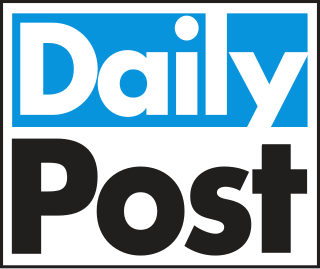
Metro International is a Swedish global media company based in Luxembourg that publishes the Metro newspapers. Metro International's advertising sales have grown at a compound annual growth rate of 41 percent since launch of the first newspaper edition in 1995. It is a freesheet, meaning that distribution is free, with revenues thus generated entirely through advertising. This newspaper is primarily intended for commuters who move daily in and out of big cities' business areas, mainly during rush hours.

Metro is the United Kingdom's highest-circulation freesheet tabloid newspaper. It is published in tabloid format by DMG Media. The newspaper is distributed from Monday to Friday mornings on trains and buses, and at railway/Underground stations, airports and hospitals across selected urban areas of England, Wales and Scotland. Copies are also handed out to pedestrians.
DMG Media is an intermediate holding company for Associated Newspapers, Northcliffe Media, Harmsworth Printing, Harmsworth Media and other subsidiaries of Daily Mail and General Trust. It is based at 9 Derry Street in Kensington, west London.
The Denver Daily News is a former free daily newspaper in Denver, Colorado. At the time of its closure on June 6, 2011, it distributed 25,000 copies Monday through Friday in stores, coffee shops, restaurants and workplaces. Copies could also be found in the Daily's distinctive blue boxes.
The Daily News, originally the Palo Alto Daily News, is a free newspaper owned by MediaNews Group and located in Menlo Park. Founded in 1995, it was formerly published seven days a week and at one point had a circulation of 67,000. The Daily News is distributed in red newspaper racks and in stores, coffee shops, restaurants, schools and major workplaces. As of April 7, 2009 the paper ceased to be published as The Palo Alto Daily News and was consolidated with other San Francisco Peninsula Daily News titles; it published five days a week, Tuesday through Saturday. Weekday editions were delivered to selected homes. While continuing to publish daily online, The Daily News cut its print edition back to three days a week in 2013, and one day a week in 2015.
Dave Price is an American journalist who has edited, published and founded a number of free daily newspapers including the Daily News and the Daily Post in Palo Alto, California, and the Aspen Times Daily in Aspen, Colorado.
The San Mateo Daily News was a free daily newspaper in San Mateo, California published 6 days a week with an average daily circulation of 22,000. The newspaper was founded August 9, 2000 by Dave Price (journalist) and Jim Pavelich, who also published the Palo Alto Daily News. Both papers were distributed in large red newspaper racks and inside stores, coffee shops, restaurants, schools, and major workplaces. The San Mateo Daily News, along with five other Daily News editions, was sold to Knight Ridder on February 15, 2005. After McClatchy's acquisition of Knight Ridder in 2006, all six Daily News editions, including the San Mateo Daily News were bundled with the San Jose Mercury News and sold to MediaNews Group of Denver, Colorado. The surviving Daily News, papers merged on April 7, 2009.
The Redwood City Daily News was a free daily newspaper in Redwood City, California, United States, published 6 days a week with an average daily circulation of 8,000. The newspaper was founded August 9, 2000 by Dave Price and Jim Pavelich, who also published the Palo Alto Daily News. The Redwood City Daily News was adjudicated as a newspaper of general circulation by the San Mateo County Superior Court in 2001, enabling it to publish legal notices. Both the Palo Alto and Redwood City Daily News editions were distributed in large red newspaper racks and in stores, coffee shops, restaurants, schools and major workplaces. The Redwood City Daily News, along with five other Daily News editions, was sold to Knight Ridder on Feb. 15, 2005. After McClatchy's acquisition of Knight Ridder in early 2006, all six Daily News editions, including the Redwood City Daily News, were bundled with the San Jose Mercury News and sold to MediaNews Group of Denver, Colorado.
The Burlingame Daily News was a free daily newspaper in Burlingame, California published six days a week with an average daily circulation of 7,000. The newspaper was founded August 9, 2000 by Dave Price (journalist) and Jim Pavelich, who also published the Palo Alto Daily News.
The East Bay Daily News was a free daily newspaper in Berkeley, California published 5 days a week with an average daily circulation of 10,000. The newspaper was founded May 20, 2005 by journalist Dave Price and Jim Pavelich, who also published the Palo Alto Daily News. The East Bay Daily News was distributed in large red newspaper racks and in stores, coffee shops, restaurants, schools and major workplaces in Berkeley, Albany, Piedmont and Oakland. After McClatchy's acquisition of the paper's previous owner Knight Ridder in early 2006, the Palo Alto Daily News group, including the East Bay Daily News, was bundled with the San Jose Mercury News and sold to MediaNews Group of Denver, Colorado.
The Los Gatos Daily News, now called the Los Gatos News was a free newspaper in Los Gatos, California published 3 days a week. The newspaper was founded May 15, 2002 by Dave Price (journalist) and Jim Pavelich, who also published the Palo Alto Daily News. Both papers were distributed in newspaper racks and in stores, coffee shops, restaurants, schools and major workplaces. The Los Gatos News, along with five other editions, was sold to Knight Ridder on Feb. 15, 2005.
The Daily Post was a free newspaper based in the San Francisco, California area.
London Lite was the trading name of a British free daily newspaper, published by Associated Newspapers, and now defunct. It was available Monday to Friday afternoons and evenings from street distributors in Central London only. On 27 October 2009, Associated Newspapers announced that it had entered into negotiation with staff over the future of the paper. The last edition was published on Friday, 13 November 2009, a date chosen by staff for its swan song.

The London Paper was a free daily newspaper, published by NI Free Newspapers Ltd, a subsidiary of News International. It was available from Monday to Friday each week in Central London from 4 September 2006 until 18 September 2009.
Diana Diamond is an American journalist who has edited a number of newspapers including the Palo Alto Daily News, and was a columnist at the Palo Alto Weekly. At the Silicon Valley/San Jose Business Journal, she was editor of their magazine, Valley Life Quarterly, and a columnist and editorial writer for the Journal. After serving as associate editor and twice-weekly columnist for the Palo Alto Daily Post she later wrote a twice-weekly column for the Palo Alto Daily News on political topics of interest to the city, the state and the nation, a thrice monthly column for The Mercury News and a blog for Palo Alto Online called "An Alternative View."

The media in the San Francisco Bay Area has historically focused on San Francisco but also includes two other major media centers, Oakland and San Jose. The Federal Communications Commission, Nielsen Media Research, and other similar media organizations treat the San Francisco-Oakland-San Jose Area as one entire media market. The region hosts to one of the oldest radio stations in the United States still in existence, KCBS (AM) (740 kHz), founded by engineer Charles Herrold in 1909. As the home of Silicon Valley, the Bay Area is also a technologically advanced and innovative region, with many companies involved with Internet media or influential websites.

The Daily Post is a free newspaper in Palo Alto, California, founded in 2008 by the Palo Alto Daily News's founders, Dave Price and Jim Pavelich, who had sold that paper to new owners three years earlier. The Post is published Monday-Saturday and distributed in more than a dozen communities on the San Francisco Peninsula. The paper covers local news and carries reports from the Associated Press.

The i is a British national newspaper published in London by Daily Mail and General Trust and distributed across the United Kingdom. It is aimed at "readers and lapsed readers" of all ages and commuters with limited time, and was originally launched in 2010 as a sister paper to The Independent. It was later acquired by Johnston Press in 2016 after The Independent shifted to a digital-only model. The i came under the control of JPIMedia a day after Johnston Press filed for administration on 16 November 2018. The paper and its website were bought by the Daily Mail and General Trust (DMGT) on 29 November 2019, for £49.6 million. On 6 December 2019 the Competition and Markets Authority served an initial enforcement order on DMGT and DMG Media Limited, requiring the paper to be run separately pending investigation.
Dave Danforth is an American publisher and newspaper owner. In the United States, he pioneered micro-daily newspapers beginning in the late 1970s, including Colorado's Aspen Daily News.







